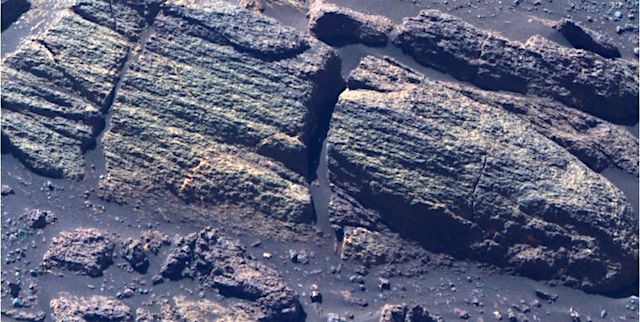 January 31, 2018: Mission Completes 14 Years of Exploring, Opportunity Roves into Year 15: Amidst the breakneck pace of increasingly disturbing news commanding the headlines in America and around the world, something extraordinarily wonderful, something unifying for all Earthlings happened on the Red Planet, and it went all but unnoticed.
January 31, 2018: Mission Completes 14 Years of Exploring, Opportunity Roves into Year 15: Amidst the breakneck pace of increasingly disturbing news commanding the headlines in America and around the world, something extraordinarily wonderful, something unifying for all Earthlings happened on the Red Planet, and it went all but unnoticed.
The Mars Explorations Rovers (MER) team quietly completed 14 years of surface operations and then Opportunity, the longest-lived robot on another planet, kept on roving into the mission’s 15th year and a whole new Martian scene. It is an unparalleled achievement in planetary exploration.
(…)
“It’s a remarkable thing,” reflected MER Principal Investigator Steve Squyres, of Cornell University. “It’s important to not lose that sense of wonder and that sense of how fortunate we are to be able to do what we do. Nobody got into this to get rich. Nobody got into this to get famous. We got into it because we love that feeling of exploration.”
(…)
Opportunity homed in on a textured rock the team named Jornada del Muerto, which, again, looked like the San Miguel outcrop rocks. Although the research on these distinctive new rocks had just begun, the scientists were beginning to refer to identify them as San Miguel class. On Sol 4975 (January 21, 2018), the rover bumped for 1.32 meters (4.35 feet) to put Jornada del Muerto in reach of her IDD or robotic arm so she could examine it up close.
The robot field geologist then examined the rock using the routine science protocol, taking the MI pictures needed for a mosaic of the target spot on Sol 4977 (January 23, 2018), and then placing her APXS on the target.
Opportunity continued her work on Jornada del Muerto during the final week of the month. On Sols 4984 and 4985 (January 30, 31, 2018), she took more MI’s and APXS integrations after off-setting the instruments just a skosh from the previous target spot on the rock to look at it again. The rover was also slated to take more color Pancam images of the margins and areas around the north fork and of her immediate surroundings.
(…)
At the same time, Perseverance Valley is proving to be “complicated,” Arvidson said. “There are things that are becoming clear and we’re still puzzling about other things. For example, we’ve talked about wind etching of the rocks, the wind blowing up hill and these little wind tails in the rocks. What’s also becoming clear is that there’s a lot of regolith in the troughs and it is slowly marching downhill, down the valley, and is building up against the uphill sides of outcrops….” [More at link]








